| ABOUT US → THOR GUARD LIGHTNING PREDICTION VERIFICATION CASE STUDY 2011 |
| This case study was conducted during the period from 16 July to 10 September 2011 at a hydroelectric energy building. The purpose of this case study was to verify the accuracy of the Thor Guard Lightning Prediction Warning System to warn people on the crown of the dam from the risk of lightning. This case study consists of two parts covering the periods from 15 July to August 9 (Part 1) and from 10 August to 10 September (Part 2). |
| BACKGROUND |
Thor Guard Lightning Prediction Warning Systems are popular among golf clubs, airports, parks, industrial sites, television stations, broadcasting and sports facilities among others. It is a predictive warning system based on ongoing monitoring of the local electrostatic field and algorithms based on years of observation. This allows Thor Guard to predict the occurrence of a lightning threat is sufficiently in advance to take the appropriate preventive steps to increase safety. The basic components of the system includes an electrostatic sensor and CPU known as a L75. The system may extend its warning using acoustic (sound siren) and visual (strobe light) alarms via RF and solar panels, meaning they can be easily installed nearly anywhere. The alarms can be activated automatically or manually. The system defines the degree scale of lightning risk assessment in the form of four states: All Clear, Caution, Warning and Red Alert (default alarm condition). The advantage of the system is it's ability to adjust the range as needed, so it can be adapted to protect the desired environment. Thor Guard defines the local field and electrostatic factors as follows: LHL or Lightning Hazard Level (lightning risk assessment), DI or Dynamic Index (immediate lightning threat assessment), AD or Activity Detector (evaluation of time to alleviation of the hazard), FCC or Field Collapse Counter (number of registered intensifications). |
| FACTS & FIGURES |
Thor Guard Lightning Prediction Warning indications were compared with reports from a commercial detection network. The commercial lightning detection network is based on the TOA technique (time of arrival) opitmizing GPS to register lightning strike locations. The location of a discharge in the network is available up to one minute from the moment of it's occurence. In the first stage of testing, observations were carried out with the Thor Guard Lightning Prediction Warning System set at a range of 15. The colors represented below on the following graphs display durations of recorded alarm states of Caution (yellow), Warning (orange) and Red Alert (red). The timing and location of lightning strikes is shown within a distance of 50 km from the location of Thor Guard sensor. |
| 16 July 2011 - Range 15 |
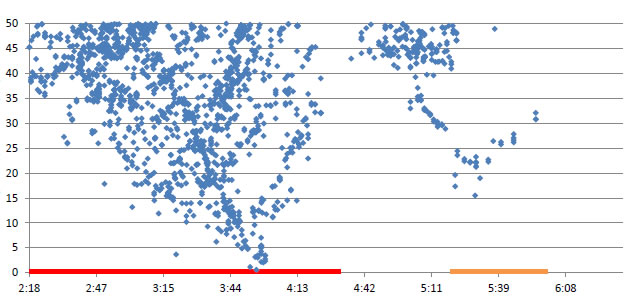 |
| 19 July 2011 - Range 15 |
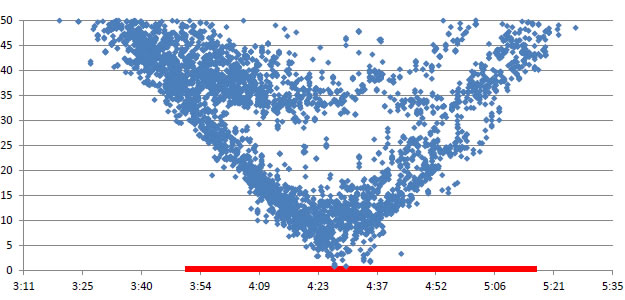 |
| 20 July 2011 - Range 15 |
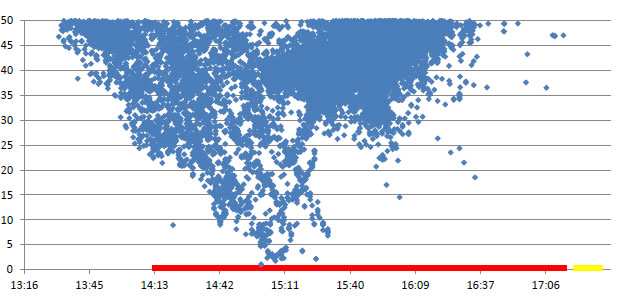 |
| 24 July 2011 - Range 15 |
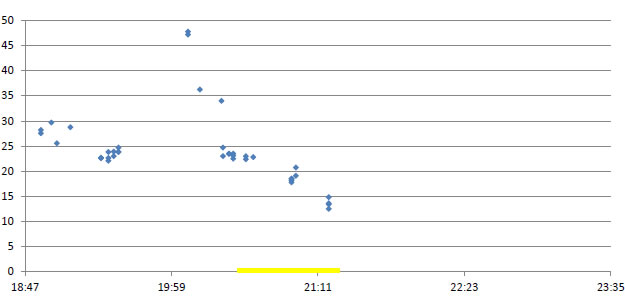 |
| 25 July 2011 - Range 15 |
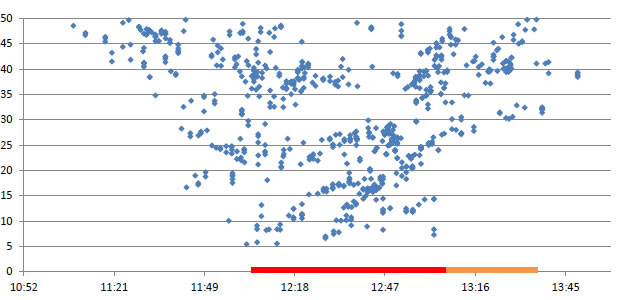 |
| 08 August 2011 - Range 10 |
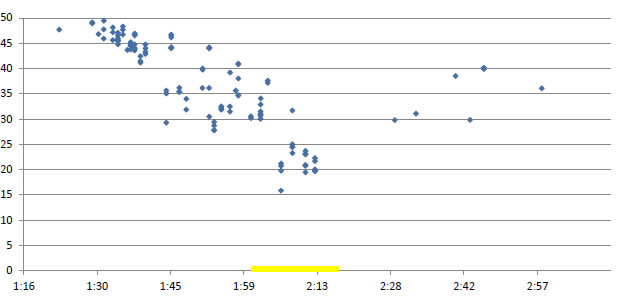 |
| 08 August 2011 - Range 10 |
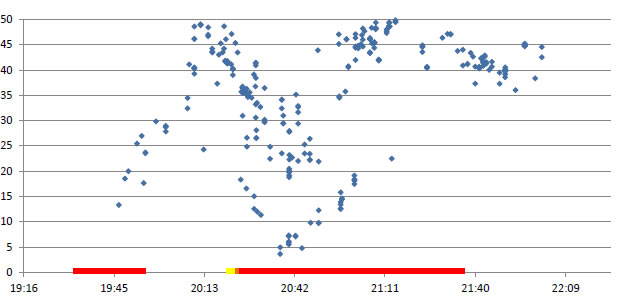 |
| 09 August 2011 - Range 10 |
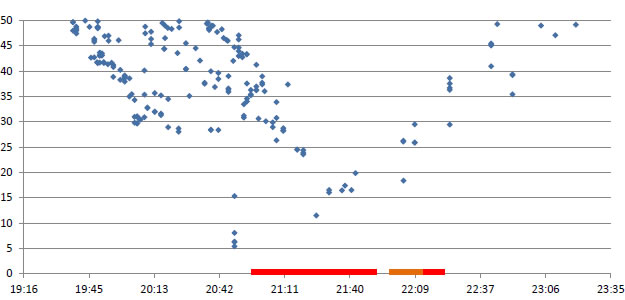 |
| CHART - Analysis of Red Alert/All Clear Times to Lightning Strike Distance |
 |
| SENSOR LOCATION AT HYDROELECTRIC DAM |
 |
| ANALYSIS OF RESULTS |
| In the period from 16 July to 9 August were 8 cases of Red Alert. During 7 of the 8 Red Alerts, lightning was measured by the detection network to be less than 15 km away with 5 cases less than 5 km and 3 cases less than 1 km. Red Alerts were mostly during the day, 2 of the 8 cases, with the other 6 cases at night. Total duration of the Red Alerts were 10 hours and 25 minutes therefore accounting for 1.7% of the observation time.
No information was gathered about a storm on 16 July due to buffer overwrite on the L75, however this problem does not occur when using the ThorPCX software which has no memory limitations of data storage. Both on 19 July and 20 July were strong storms the passed through with lightning measured by the detection network at less than 1 km. Thor Guard triggered a Red Alert in advance of both storms at respectively 36 and 48 minutes before the closest strike. On 24 July, the detection network registered a strike around 12 km, however the Thor Guard did not trigger a Red Alert, but rather only a Caution. On 25 July, the Thor Guard registered a Red Alert 8 minutes after lightning was detected at 5 km and the lightning did not strike any closer during the remainder of the storm. On 28 July, the Thor Guard range settings were manually changed from 15 to 10. On 08 August, the detection network measured lightning at 15 km and the Thor Guard did not go to Red Alert, but rather stayed at a Caution. On that same day, a Red Alert was triggered by the Thor Guard 14 minutes in advance of a strike measured by the detection network at 13 km. Then later that same day, 08 August, a third storm caused Thor Guard to trigger a Red Alert 13 minutes before the detection network measured lightning less than 5 km away. On 09 August, there were 2 Red Alerts triggered within 20 minutes of each other. The first of these Red Alerts was triggered about 8 minutes after a strike measured by the detection network at 5 km. Another strike was measured 30 minutes later at a distance of 10 km during that same Red Alert period. During the second Red Alert on 09 August that lasted 9 minutes, the detection network did not record any lightning strikes. Given that time registered in that storm, no weather was synonymous with a lack of threat. Observed data indicated that an alarm followed when the storm withdrew to about 30-35 km. Maintaining an appropriate interval of time before the threat is resolved is necessary to avoid frequent switching between states of warning. Also it is recommended to deliberate and maintain the alarm state after the threat has resigned. Reducing the sensitivity of the system resulted in shortening the time of warning on the basis of differences in time between the moment the alarm was triggered and the recording of the first lightning strike measured within 5 km. Again 6 of the 8 Red Alerts were recorded at night and their evaluation was only carried out on the basis of the information stored in the memory unit of the L75. In the case of 2 states (20 July and 25 July), it was possible to compare observations with the workers building the plant. On 20 July, the Red Alert was triggered at 14:13, at the time was observed an increase in cloud cover. Around 14:30 hours, the wind worsened and the clouds thickened even more. About 14:47, rain and thunder were first observed. The storm was strongest at 14:55 which coincides with the lightning detection network reports of strikes within 1-2 km. According to the L75, the saved DI values were also greatest during the lightning discharges at the closest distances. |
| CONCLUSIONS |
| On the basis of the observations during the period from 15 July to 09 August, comparitive analysis of the Red Alert times allow for formulation of the following conclusions:
- Red Alert conditions are always triggered only if it occurred or there was a large fault in close proximity. - There was no situation where there was a direct threat for lightning and the Red Alert condition had not been liberated. - In all cases, when the thunderstorm passed directly over the dam (16 July, 19 July and 20 July) and the lightning detection network measured lightning less than 1 km, Red Alert was triggered with an appropriate amount of advanced warning to safely evacuate people from the crown of the dam. It was clearly noticeable that the lead time of the Red Alert condition being triggered was greater during the most severe storms, especially between 16 July to 20 July. - Observations showed the Thor Guard system predicting the first lightning storm on 08 August representing a significant advantage over detection systems and networks. - During the observation there was no influence or power switching operations or nearby high-voltage lines that could malfunction the system. Dr. Tomasz Maksimowicz |